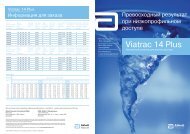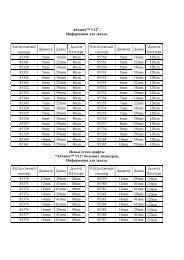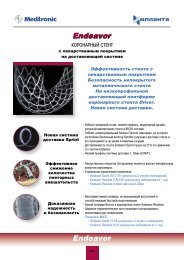Results of Coronary Stenting using the Stents with
Results of Coronary Stenting using the Stents with
Results of Coronary Stenting using the Stents with
You also want an ePaper? Increase the reach of your titles
YUMPU automatically turns print PDFs into web optimized ePapers that Google loves.
Interventional cardiology<br />
<strong>Results</strong> <strong>of</strong> <strong>Coronary</strong> <strong>Stenting</strong> <strong>using</strong> <strong>the</strong> <strong>Stents</strong> <strong>with</strong><br />
Biodegradable Polymer and Antiproliferative (Biolimus A9)<br />
Coating<br />
R.V. Zeynalov 1 , D.A. Asadov, M.B. Matini, V.V. Mazurova., D.G. Gromov, O.V. Zakharova, A.G. Koledinsky,<br />
D.G. Iosseliani.<br />
Moscow City Center <strong>of</strong> Interventional Cardioangiology, Moscow, Russia<br />
The study comprised two groups <strong>of</strong> patients <strong>with</strong> coronary artery disease. Then patients from Group 1 received<br />
DES <strong>with</strong> biodegradable coating, and <strong>the</strong> patients from Group 2 – DES <strong>with</strong> permanent polymer coating.<br />
Baseline clinical, historic and angiographic characteristics were comparable in both groups. The rate <strong>of</strong><br />
restenosis in <strong>the</strong> mid-term follow up was similar in both groups. The rate <strong>of</strong> thrombosis was reliably lower in<br />
<strong>the</strong> group <strong>of</strong> DES <strong>with</strong> biodegradable polymer coating.<br />
Keywords: DES, stents <strong>with</strong> biodegradable polymer coating, Biomatrix stents.<br />
Purpose <strong>of</strong> study: to determine <strong>the</strong> effectiveness<br />
<strong>of</strong> <strong>the</strong> use <strong>of</strong> drug-eluting stents (DES) <strong>with</strong><br />
biodegradable polymer coating (Biomatrix) in comparison<br />
<strong>with</strong> DES <strong>with</strong> permanent polymer coating<br />
(«Cypher») in patients <strong>with</strong> coronary artery disease<br />
(CAD).<br />
Material and methods: <strong>the</strong> study comprised 117<br />
patients in whom a total <strong>of</strong> 235 stents have been implanted.<br />
The patients were divided into 2 groups. The<br />
patients from Group 1 (n=51) received 110 Biomatrix<br />
stents. The patients from Group 2 (n= 66) received<br />
125 Cypher stents. The final purpose <strong>of</strong> <strong>the</strong> study<br />
consisted in <strong>the</strong> comparison <strong>the</strong> rate <strong>of</strong> restenosis<br />
and thrombosis <strong>of</strong> <strong>the</strong> above stents in <strong>the</strong> mid-term<br />
follow-up.<br />
<strong>Results</strong>: <strong>the</strong> rate <strong>of</strong> restenosis in <strong>the</strong> mid-term<br />
was 2,72% in <strong>the</strong> group <strong>with</strong> Biomatrix stents and<br />
3,2% — in <strong>the</strong> group <strong>with</strong> Cypher (р>0.05). The rate<br />
<strong>of</strong> thrombosis in <strong>the</strong> studied groups was significantly<br />
different — 0% and 3,2%, respectively (р< 0.05)<br />
Conclusions: <strong>the</strong> effectiveness <strong>of</strong> <strong>the</strong> stents <strong>with</strong><br />
bidgradable polymer coating is comparable <strong>with</strong> <strong>the</strong><br />
effectiveness <strong>of</strong> <strong>the</strong> stents <strong>with</strong> permanent polymer<br />
coating. At <strong>the</strong> same time <strong>the</strong> rate <strong>of</strong> thrombosis after<br />
<strong>the</strong> implantation <strong>of</strong> Biomatrix stents is significantly<br />
lower than <strong>with</strong> Cypher stents.<br />
Introduction<br />
Large-scale implementation <strong>of</strong> DES into <strong>the</strong><br />
clinical practice has allowed to improve <strong>the</strong> results <strong>of</strong><br />
stenting due to <strong>the</strong> reduction <strong>of</strong> <strong>the</strong> rate <strong>of</strong> restenosis.<br />
The first clinical trials demonstrated significant<br />
1<br />
Address for correspondence :<br />
Dr. Rufat Zeynalov,<br />
Moscow City center <strong>of</strong> Interventional Cardioangiology<br />
Russia, 101000, Moscow,<br />
Sverchkov per., 5<br />
Phone: +7 495 624 96 36<br />
Fax: +7 495 624 67 33<br />
e-mail: zeynalovrufat@hotmail.com<br />
Manuscript received on September 17, 2011<br />
Accepted for publication on September 29, 2011<br />
advantages <strong>of</strong> first-generation stents in comparison<br />
<strong>with</strong> balloon angioplasty and stenting <strong>with</strong> bare metal<br />
stents. However after mass introduction <strong>of</strong> DES into<br />
<strong>the</strong> practice, in particular, in multiple extended coronary<br />
lesions as well as in <strong>the</strong> presence <strong>of</strong> several risk<br />
factors, <strong>the</strong> increase <strong>of</strong> <strong>the</strong> rate <strong>of</strong> late restenoses and<br />
thromboses became evident. One <strong>of</strong> <strong>the</strong> main causes<br />
<strong>of</strong> <strong>the</strong>se serious cardiac complications consist in <strong>the</strong><br />
presence <strong>of</strong> permanent (non-soluble) polymer stent<br />
coating. The impact <strong>of</strong> this coating on <strong>the</strong> vascular<br />
wall contributes to <strong>the</strong> development <strong>of</strong> stent restenosis<br />
and thrombosis after <strong>the</strong> end <strong>of</strong> <strong>the</strong> drug action<br />
(1,2,3).<br />
The introduction <strong>of</strong> DES <strong>with</strong> biodegradable<br />
(soluble) polymer coating represents an attempt to<br />
eliminate this side effect, thus decreasing <strong>the</strong> rate<br />
<strong>of</strong> unfavorable results <strong>of</strong> treatment. Such stents are<br />
made <strong>of</strong> a steel frame and polylactic biodegradable<br />
polymer coating impregnated <strong>with</strong> a medication —<br />
Biolimus А9. Due to <strong>the</strong> abluminal coating as well as<br />
to <strong>the</strong> polymer’s capacity to get degraded <strong>with</strong>in 6-9<br />
months <strong>with</strong> <strong>the</strong> formation <strong>of</strong> water and carbon dioxide,<br />
<strong>the</strong>se stents decrease <strong>the</strong> rate <strong>of</strong> late restenosis<br />
and thrombosis, thus contributing to full endo<strong>the</strong>lization<br />
<strong>of</strong> <strong>the</strong> inner surface (4).<br />
Methods<br />
In conformity <strong>with</strong> <strong>the</strong> purpose and <strong>the</strong> tasks we<br />
present <strong>the</strong> data <strong>of</strong> examination and treatment <strong>of</strong><br />
patients <strong>with</strong> coronary artery disease (CAD) in <strong>the</strong><br />
Moscow City Center <strong>of</strong> Interventional Cardioangiology<br />
during <strong>the</strong> period from 2008 to 2010.<br />
The patients have been selected for <strong>the</strong> study on<br />
<strong>the</strong> base <strong>of</strong> <strong>the</strong> following criteria:<br />
– CAD diagnosed on <strong>the</strong> base <strong>of</strong> an extensive<br />
clinical and instrumental examination;<br />
– documented painless ischemia or stable angina<br />
<strong>of</strong> effort assessed in conformity <strong>with</strong> ACC/AHA classification;<br />
– primary, not restenotic character <strong>of</strong> coronary<br />
arterial narrowing <strong>with</strong>out <strong>the</strong> signs <strong>of</strong> fresh parietal<br />
thrombi;<br />
16<br />
(№ 26, 2011)
















